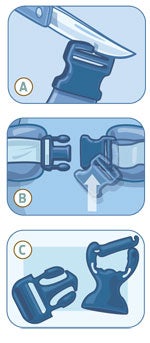Rip & Equip: Backpacks
Finding a great fitting backpack is the key to happy backpacking. Plus, learn how to keep your pack looking and feeling like new.
Shop Smart | Fit & Size | Care Instructions
Shop Smart
Ask yourself five key questions before buying a new pack.
1. How much cargo capacity? This depends on the length and conditions of your trips, of course, and personal preferences (ultralight or ultraluxe?). As a general rule, choose a pack that accommodates your largest load, as it’s easier to compress a too-big pack than to overload a too-small one.
2. What type of pack? If your load often exceeds 40 pounds, choose a standard internal frame, constructed with a rigid suspension and durable, higher-denier fabrics. Expect the pack alone to weigh about four pounds. Lightweight packs with thinner padding and streamlined pockets are ideal for weekend loads under 40 pounds. If your base weight is 15 pounds or less, consider a true ultralight pack (less than two pounds) with thin aluminum stays or no frame structure at all (a rucksack).
3. What’s your size? Short people can have long torsos—and vice versa—so measure your back and check specific brands’ sizing. Generally, if your torso is shorter than 16 inches, try an extra small; 16 to 18 inches is small; 18 to 20 inches is medium; 20 or more inches is large. Many brands also offer interchangeable, sized hipbelts.
4. What features? Are you an organizer or a minimalist? Identify the extras you absolutely need—water bottle holsters, external gear attachments, shove-it or hipbelt pockets, ski loops, extendable lid—and don’t waver.
5. Does it really fit? Packs are like shoes: Even the right size might not be a perfect fit for your body type or shape, so test it thoroughly in the store.
>> Loosen all straps, then throw on the pack (loaded with about 20 pounds).
>> Buckle and cinch the hipbelt. Padding should be centered over the hipbones.
>> Tighten the shoulder straps, load lifters, sternum strap, and hip stabilizers (in that order). Now walk around and evaluate the fit: Does the lumbar pad sit snugly in the small of your back? Do the shoulder straps wrap over your shoulders with no visible gaps? Can you distribute the weight evenly between your shoulders and hips, with no rubbing or pressure points?
Shopping Tips
In-store
To get the best fit, try on multiple packs so you can feel the differences between a variety of brands and models. Also ask about swapping components (like putting a medium hipbelt on a large pack) to help dial in the fit. When you’ve settled on a couple of favorites, pack them: Bring your own gear to the store (or borrow equipment from the store shelves) to double-check the pack’s cargo capacity and make sure it feels good fully-loaded.
Online
Web shopping is especially tricky if you can’t try the pack on first. If you’re unsure about your exact size, choose a model that can be modified (with an adjustable suspension and interchangeable hipbelts) and read user reviews for hints about manufacturer sizing. Another option: Limit online buying to daypacks and overnight bags, where loads are smaller and a less exact fit will suffice. Shop outfitters, guide programs, and rental shops in the fall—many dump used rental gear then (our favorite: whittakermountaineering.com).
Shop Smart | Fit & Size | Care Instructions
Measure Your Torso
>> Recruit a friend and find a soft tape measure.
>> Bow your head so the C7 vertebra at the base of your neck protrudes. This is the top of your
torso measurement.
>> Find your hips. Place your thumbs on your iliac crests (tops of hipbones). Draw an imaginary line across your back connecting your thumbs. The point where the line crosses your spine is the bottom of your torso.
>> Take the measurement. Have your friend measure from the top of your torso to the bottom. Most adults fall between 15 and 22 inches. For a video demo go to backpacker.com/torso.
What’s Inside
Pack capacity is measured in liters or cubic inches. Multiply liters by sixty to get cubic inches–or use our chart to gauge real-world space.
Boost Comfort
Balance your load for a more comfortable fit—and to reduce wear and tear on your pack. Follow Gear Editor Kristin Hostetter’s tips for on-trail pack adjustments at backpacker.com/packstraps.
Shop Smart | Fit & Size | Care Instructions
Care Instructions
Clean
Caked-on grime can degrade a pack’s water-resistant coating and clog the zippers, so clean your pack at least annually. Dunk it in a tub of warm, sudsy water (use a mild dish soap like Palmolive), and scrub with a sponge or brush. Rinse well, stuff the inside with newspapers, and hang dry. Never put your pack in the washing machine; it will tear it apart. Also, avoid DWR-damaging hot water, bleach, and spot stain removers.
Never Do This
>> Secure heavy items on a pack’s outside. Pack weighty gear inside for better balance, so you don’t lose gear, and to avoid stressing seams.
>> Check your pack unprotected for airline travel. Protect your pack by putting it into a giant duffel. If it doesn’t fit fully-loaded, you may be able to squeeze it in if it’s unpacked. Don’t have a big duffel? Ask check-in personnel for a protective plastic bag to cover your pack (they’re usually free).
>> Overstuff a zippered pocket. If you have to yank on a zipper to get it closed, there’s too much inside that compartment, and you run the risk of damaging the slider. Instead, redistribute the contents so the zipper closes easily.
Repair
>> Fabric that’s no longer water-resistant If water soaks the material instead of beading on it, spray your pack with a waterproofer, such as Nikwax Tent & Gear Proof.
>> Zippers that snag Vacuum out the dust, scrub the zippers with a wet toothbrush, and then grease the chain with a lubricant like McNett Zip Care (lip balm also works in a pinch).
>> Blown-open zipper If the chain’s teeth or coils aren’t aligned
correctly—or if the slider has worn down and lost traction—the zipper can split open, spilling your gear. Open the zipper all the way to the bottom, and then gently squeeze the sides of the slider with pliers and move it up and down to realign the teeth and tighten the slider. If this doesn’t work, replace the slider.
>> Frayed fabric Superglue the torn edges together for a quick fix. Apply McNettSeam Grip once it dries to make the repair last longer. Seamsters or manufacturer-approved services like stitchlines.com may be able to mend major damage (e.g., torn-off shoulder straps) for as little as $20.
>> Packbag hole Trim the loose threads and patch with McNett Gear Aid Fabric Repair Patches. Cut patch into a round (to prevent peeling corners) that’s at least one-half-inch larger than the hole on all sides. Apply with pressure on the pack’s inside. Seal the edges with Seam Grip.
>> Broken buckles To replace a hipbelt or shoulder strap buckle in the field, cut off a less-critical buckle, like one from a side strap or the lid. Find the thin plastic bar that the strap threads under and slice it in the center (A); you can heat the plastic with a lighter to soften it. Slide the strap through the slit (B), then duct-tape the bar back together (covering the slit). Tip: Repair buckles, such as Liberty Mountain Quick Attach Buckle ($1.50, libertymountain.com), have a hinged plastic bar (C); pack one or more in your repair kit to ease on-trail replacement. Watch a video demo of a buckle replacement in the field at backpacker.com/buckle.


Use
>> Wrap hard-edged items like fuel canisters inside your clothes so the pack’s fabric doesn’t abrade where you rub against rocks. Stow crampons in a burly, puncture-resistant bag or put rubber point guards over the tips (both are available at most outdoor stores).
>> Remove food—even crumbs—from your bag at night so mice and squirrels don’t gnaw their way in. Hang it from a tree for extra protection, since lingering odors and salt residue on sweat-soaked shoulder straps or padding can draw animals, too.
>> Double-bag messy items, like insect repellent and sunscreen. Leaked chemicals can damage fabrics and DWR finishes.
>> Stow gear in trash bags or waterproof stuffsacks to keep it dry.
>> Keep pack weight to 30 percent or less of your body weight. Some tough folks can handle more, but their knees won’t like it.
>> Give ultralight packs extra TLC. Many of them are made with gossamer fabrics like silnylon, which weigh about 50 percent less than other materials but are also less abrasion-resistant. Follow these six tips for giving your ultralight pack a long, happy life:
1. Keep the total weight—including food, water, and fuel—below 25 pounds for frameless packs and 30 pounds for ultralighters with aluminum stays. Since the packs themselves only weigh about one to 1.5 pounds, they can’t support mammoth loads.
2. Don’t yank compression straps. Tug gently.
3. Avoid lashing heavy items to the side, which can blow out seams. Store them in the center, surrounded by softer gear.
4. Reinforce high-wear areas (like the pack bottom) with McNett Sil Fix (for silnylon packs) or Seam Grip for other fabrics.
5. Avoid bushwhacking if possible, and don’t sit on your pack.
6. For extra support and comfort, insert your sleeping pad along the backpanel or in the backpanel sleeve made for that purpose.
Tips from a Pro
“Toss your pack around like a gym bag and it will meet an early demise. Preserve the integrity of shoulder straps and stitching by lifting your pack by the haul loop, just below the top lid. If your pack is too heavy, get help from a hiking partner, prop it on a log, or use the following method that protects your pack (and spine): Bend one leg into a shallow lunge; pick up the pack by the haul loop and place it on your front, bent thigh, making sure the shoulder straps are facing you. With one hand still holding the loop, twist your torso and slide an arm through the far shoulder strap; bend forward to shift the weight onto your back and slide the other arm through the strap.”
— Excerpted from BACKPACKER’s Complete Guide to Outdoor Gear Maintenance and Repair ($20, falconguides.com)
Boost Comfort
Balance your load for a more comfortable fit—and to reduce wear and tear on your pack. Follow Gear Editor Kristin Hostetter’s tips for on-trail pack adjustments at backpacker.com/packstraps.
